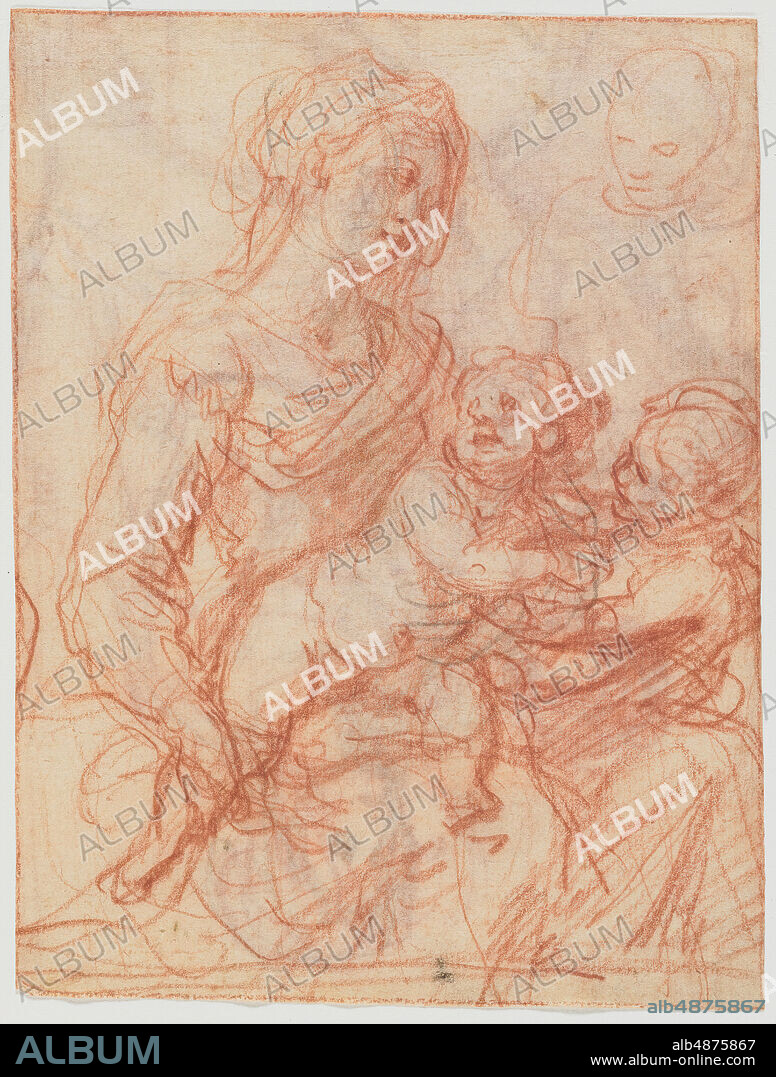alb4875867
Francesco Vanni, The Holy Family with Saint John (recto), 1584-1610, red chalk over black chalk on paper, 7 in. x 5 1/4 in. (17.78 cm. x 13.4 cm.), This double-sided drawing experiments with different compositions of one of the most beloved figurative groups in Italian art, the Madonna and Child. While the recto presents an intimate scene that brings together Jesus and Saint John in their infancy, with Mary thoughtfully providing motherly support, the verso focuses on Mary and her child alone. The appeal of the scenes is obvious, each compositional nuance translates into a slightly different emotional (and theological) balance between motherly love, a child's affection, and the anticipation of Christ's sacrifice. As Bowdoin Professor Susan Wegner demonstrated, Vanni's rapid sketch relates to a group of small paintings of the Madonna that Vanni created around 1600. The Sienese artist most likely filled a larger sheet with such drawings, from which the exhibited detail was cut off.

|
Añadir a otro lightbox |
|
Añadir a otro lightbox |



¿Ya tienes cuenta? Iniciar sesión
¿No tienes cuenta? Regístrate
Compra esta imagen.
Selecciona el uso:

Descripción:
Ver traducción automática
Francesco Vanni, The Holy Family with Saint John (recto), 1584-1610, red chalk over black chalk on paper, 7 in. x 5 1/4 in. (17.78 cm. x 13.4 cm.), This double-sided drawing experiments with different compositions of one of the most beloved figurative groups in Italian art, the Madonna and Child. While the recto presents an intimate scene that brings together Jesus and Saint John in their infancy, with Mary thoughtfully providing motherly support, the verso focuses on Mary and her child alone. The appeal of the scenes is obvious, each compositional nuance translates into a slightly different emotional (and theological) balance between motherly love, a child's affection, and the anticipation of Christ's sacrifice. As Bowdoin Professor Susan Wegner demonstrated, Vanni's rapid sketch relates to a group of small paintings of the Madonna that Vanni created around 1600. The Sienese artist most likely filled a larger sheet with such drawings, from which the exhibited detail was cut off.
Personas:
Crédito:
Album / quintlox
Autorizaciones:
Modelo: No - Propiedad: No
¿Preguntas relacionadas con los derechos?
¿Preguntas relacionadas con los derechos?
Tamaño imagen:
4548 x 6000 px | 78.1 MB
Tamaño impresión:
38.5 x 50.8 cm | 15.2 x 20.0 in (300 dpi)
Palabras clave:
ARTE ITALIANO • CABALLERO HOSPITALARIO • CABALLEROS DE MALTA • DIBUJOS • ESCENAS • FRANCESCO VANNI • GROUP • GRUPO • GRUPO. • LLENA • MADONNA • MARIA • PAPEL • PREPARADO A SANGUINA • RECTO • SAGRADA FAMILIA • TIZA NEGRA
 Pinterest
Pinterest Twitter
Twitter Facebook
Facebook Copiar enlace
Copiar enlace Email
Email
